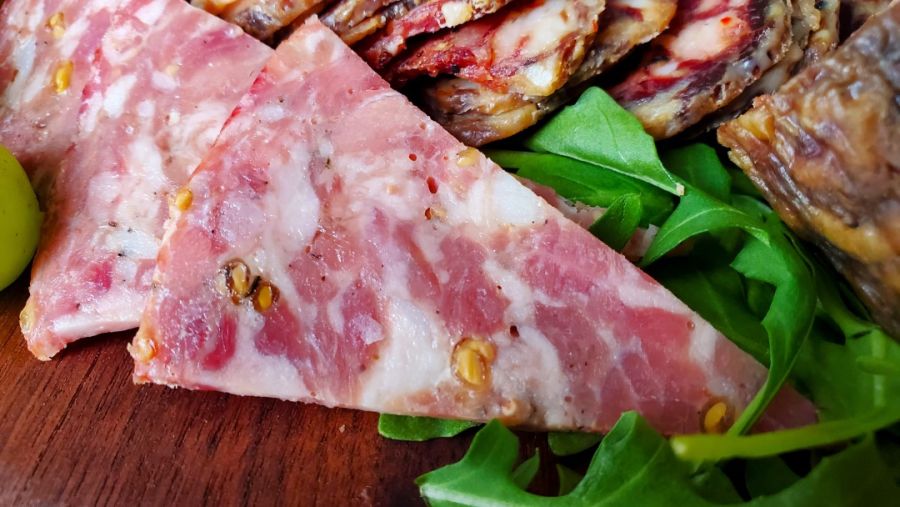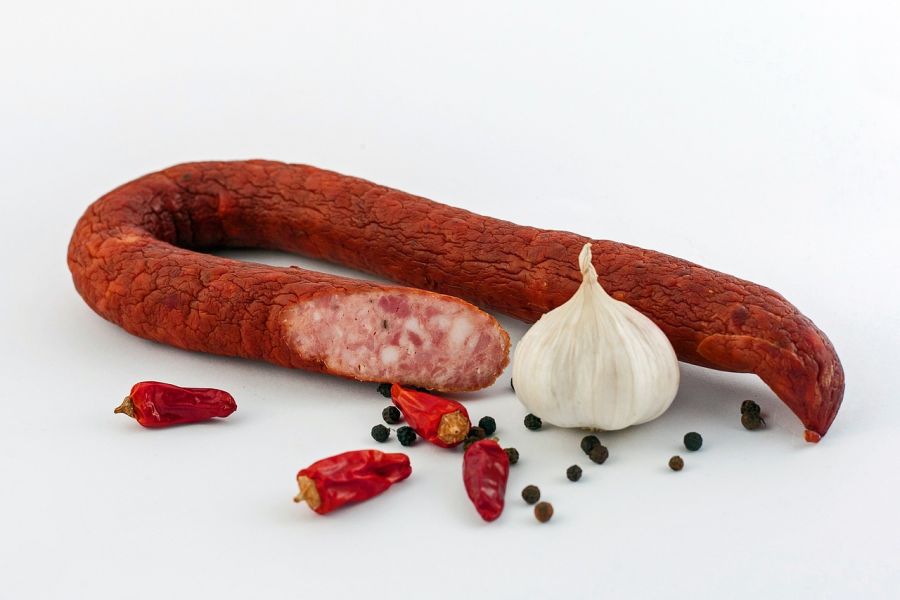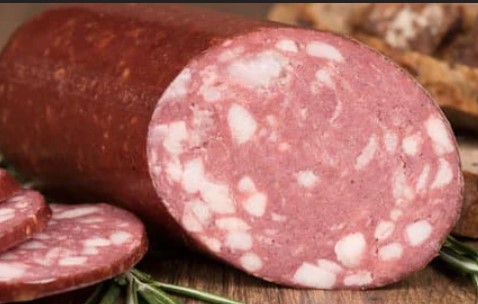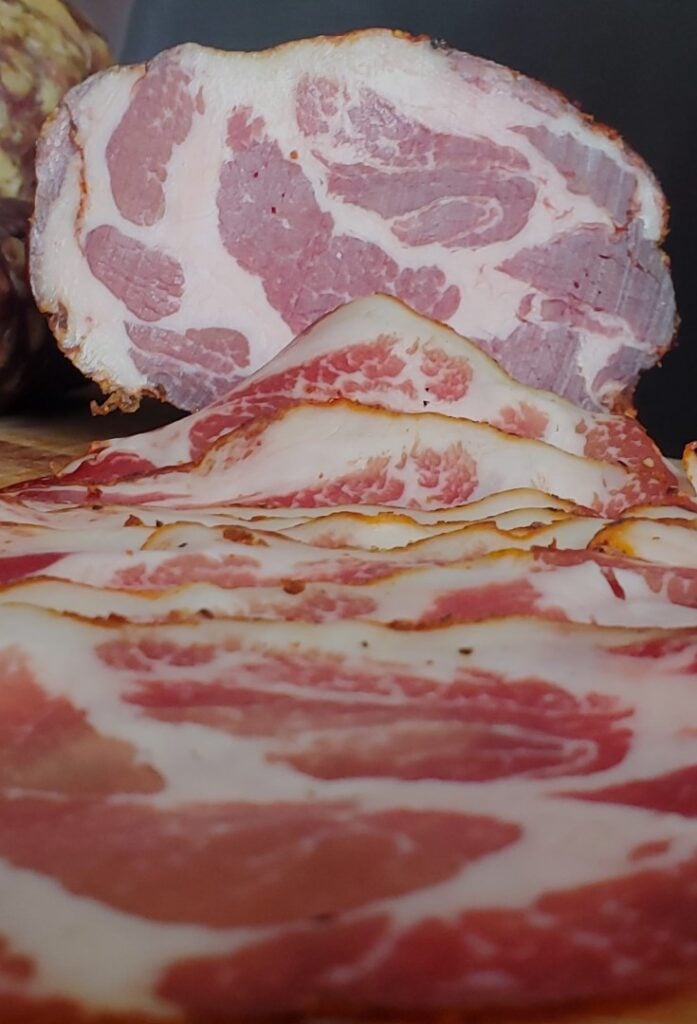Charcuterie meats can look raw, but are they? From ribbons of prosciutto to glossy slices of salami, many people wonder whether these meats are safe to eat without cooking.
Most cured meats aren’t raw, but they’re not always cooked either.
Whether you’re building a charcuterie board, browsing a deli counter, or making your own cured meats at home, it helps to understand how these meats are processed.
In this guide, I’ll walk through how different types of charcuterie are made, whether they’re cooked or dried, and how to tell the difference.
After spending decades curing meats like pancetta, lonza, and salami, I’ve learned firsthand how misleading appearances can be.
What Does “Cured Meat” Really Mean?
Curing meat is all about salt.
Long before refrigeration, people discovered that applying salt and removing moisture could extend the life of meat while transforming its flavor and texture.
However, some meat is cured but cooked to finish – therefore, it’s not always about preservation, I’ll explain.
Today, curing falls into two main categories: dry-cured meats and cooked or hot-smoked meats. Neither of these are raw in the way fresh meat is — but they’re also not all cooked in the traditional sense.
- Dry-cured meats – These are preserved without heat. Salt inhibits and draws out moisture, and the meat is dried until moisture is lost (often at least 30% of the initial meat weight, up to 50%), the texture becomes dense and sliceable. Think prosciutto, bresaola, and dry-cured salami.
- Cooked or emulsified meats – These are heated during production. Pâté, frankfurter, wiener, mortadella, and hot-smoked sausages fall into this group.
- Some charcuterie meats are also cooked preparations, like rillettes (meat slow-cooked in fat) or head cheese (a terrine made from cooked offal).
- Raw sausage that is cooked before eating is also a part of traditional charcuterie, but is not a cured meat.
The confusion often comes from how these meats look.
The perfect example is this steamed-cooked salami from Smoking Goose in Indianapolis, USA. I’ve spent time with the team, a fantastic place. This looks and even feels slightly like a dry-cured salami, but it’s not. It’s not common to see this cooked salami; technically, it’s cooked at a temperature below where the fat inside renders/melts.
It even has a ‘raw’ look to it, but it’s 100% cooked through.

Cooked vs. Cured/Dried vs. Raw: Differences
Charcuterie meats are not all processed the same way. Some are air-dried over months, others are fully cooked during preparation, and a few — like fresh sausages — are raw until cooked at home.
To make sense of the board in front of you (or your own curing project), it helps to break everything into three groups:
- Cured but not cooked – Preserved using salt and time. These are dried until firm, deeply flavored, and ready to eat without heat.
- Cooked meats – Heated during production. Often soft or emulsified, and sometimes preserved in fat or sealed packaging.
- Raw meats – Only fresh sausage fits here. These are completely raw and require cooking before eating.
Also note, meat can be cured with a wet cure/brine, then dried, and fish is often done this way, traditional for preservation.
Two of the images below are cooked salami, and the thinly sliced meat is dry-cured (Smoking Goose Coppa).
Here’s a breakdown of common charcuterie types and how they’re prepared:
| Type | Cooked? | Method |
|---|---|---|
| Prosciutto | No | Salt-cured and air-dried (dry cured) |
| Salami (Dry-Cured) | No | Salted, sometimes fermented, and dried until moisture is reduced |
| Salami (Cooked or Hot-Smoked) | Yes | Heated to cooked temps through hot smoking or steam |
| Mortadella | Yes | Emulsified and cooked in casings (steamed or baked) |
| Pâté | Yes | Cooked forcemeat, not preserved — must be chilled |
| Rillettes | Yes | Cooked then packed under a fat layer (confit-style) |
| Fresh Sausage | Yes (after cooking) | Raw, not preserved — must be cooked before serving |
| Biltong (South African) | No | Salted and air-dried; not cooked or smoked |
| Jerky | Sometimes | Dried; some recipes reach cooked temperatures |
Due to these variations, it’s not so straightforward to categorize cured meat, or call it ‘raw’.
Why Dry-Cured Meats Don’t Require Cooking
What makes dry-cured meats so unique is that they’re never exposed to high heat. Yet they undergo a remarkable transformation — thanks to salt, air, and time.
This isn’t a shortcut method. It’s a craft passed down for generations, from rustic Italian cellars to modern curing chambers. (Although modern capitalism has found ways of hacking this, and producing salami that takes just a few days – using a high concentration of acidity for instance).
These methods are about flavor, texture, and tradition, not just extending shelf life. Here’s what goes into making dry-cured meat the old-traditional way (Romans learned from the Greeks, and began to perfect this around 200BC, although the history of salt/meat goes back to 3,000BC in Mesopotamia ):
- Salt – Draws moisture out of the meat, helping concentrate flavor, preserve, develop complexity, and acidify (naturally).
- Drying – As meat hangs, it loses water weight. This gives it a dense, sliceable texture — and over time becomes a preserved thing.
- Time – Whether it’s 90 days for pancetta or 12 to 60 months for prosciutto, time adds deep umami flavor, the proteins are easier to digest, and nuanced flavors appear.
- Starter Cultures (optional) – In some salamis, good bacteria are added to guide fermentation and give that signature tanginess. These are natural around meat, although modern techniques have made them commercially available to buy as well.
- Cold Smoking – Sometimes used to enhance flavor, cold smoking uses gentle airflow and smoke well under 86°F (30°C), often acting as another drying tool rather than a cooking step. This is a traditional craft in its own right.
Other optional ingredients like curing salt (containing nitrates or nitrites) can be used depending on the style. If you’re curious about that side of the process, I explain the details in my guide on how pink curing salt works.
It’s this slow, deliberate process that makes dry-cured meats like salami, pancetta, and lonza so special — and why they don’t rely on heat the way cooked meats do.
How to Tell If a Charcuterie Meat Is Cooked or Cured
Cooked meats and cured meats can look similar, especially when thinly sliced. A few key visual and tactile clues can help you tell them apart, whether you’re buying from a deli or serving from a board.
- Texture – Dry-cured meats are usually firm, dense, and have way less moisture. Cooked meats tend to be soft, have moisture, or be emulsified (like a frankfurter).
- Slice appearance – Prosciutto and salumi often appear semi-translucent with visible muscle grain. Cooked emulsified meats like mortadella or bologna have a uniform, opaque cross-section. You can’t cut raw meat this thin unless you par-freeze it.
- Fat – Many dry-cured meats have decent amounts of fat, like pancetta from the pork belly. For dry cured salami ‘showcase’, fat can also be used to make it look more appealing and have a better mouthfeel.
- Packaging cues – After thin-sliced meat is usually dry-cured whole-muscle meat.
This overlap shows up especially with emulsified sausages, forcemeats, or terrines. If you’re exploring these styles, here’s a list of cooked sausages of the world I’ve compiled that outlines many of these crossovers.
If you’re just getting started and want to see a range of cured and cooked charcuterie projects side by side, I’ve also shared some charcuterie recipes for beginners that reflect both types in practice.

Traditional vs. Modern Charcuterie
French Traditional Charcuterie used to mean something specific: meat made through techniques like salting, confit, drying, or fermentation.
The term also was used for French products like terrines, pâtés, and fresh sausages made from pork and offal.
Today, charcuterie has evolved into a broader concept. In restaurants, shops, and especially social media, it often refers to a mixed board of meats, cheeses, crackers, nuts, and spreads — sometimes with very little that’s cured meat.
I’ve seen dessert charcuterie boards (don’t tell any French).
The Italian equivalent, salumi, is more focused: it refers specifically to salt-cured pork products and dry-cured salami. While “charcuterie” now includes both cooked and cured meats, salumi typically refers only to the cured and dried side of the spectrum. Below the Italian category of salumi is dry-cured salami also.
If you’re aiming for a traditional Italian balance, consider a mix of dry-cured meats like coppa or pancetta, alongside cooked elements such as pork pate (famous in Tuscany) or mortadella (Famous in Bologna).
Understanding this divide also helps when reading labels, sourcing authentic products, or creating your own cured meats at home.
It brings clarity to terms that are often used interchangeably, but mean very different things depending on where you’re standing.
Expert Tip: Bring It to Room Temp
Whether it’s dry-cured prosciutto or cooked mortadella, flavor opens up dramatically when served at room temperature. Take your charcuterie meats out of the fridge 30–60 minutes before serving to soften the fat and release more aroma and taste.
Alternatives to Traditional Charcuterie
If you’re exploring beyond classic pork-based charcuterie, there are plenty of options. Beef-based bresaola, venison salami, and smoked duck prosciutto all bring different textures and depth. You can also experiment with regional varieties from Spain, Germany, or Eastern Europe — each with their own cured and cooked traditions.
If you’re interested in trying the process yourself, here’s a step-by-step guide to introduce you to the craft –how to dry cure meat at home.
Are cured meats considered raw?
Not exactly. While many cured meats aren’t cooked, they’re also not raw in the traditional sense. They’ve been preserved through salting and drying, which completely changes their texture, structure, and character.
Which charcuterie meats are actually cooked?
Mortadella, pâté, rillettes, and some salami are cooked during production. These are usually softer in texture and always sold in chilled packaging.
Can cured meats be eaten without further preparation?
Yes — dry-cured meats like salami and prosciutto are meant to be eaten as they are. No additional cooking is required once they’ve been fully dried and aged. Other types of cured meats might need to be cooked like raw sausage or bacon.
Have a question or want to share your thoughts on cooked vs cured meats? Drop a comment below — I’d love to hear from you.

Tom Mueller
For decades, immersed in studying, working, learning, and teaching the craft of meat curing, sharing the passion and showcasing the world of charcuterie and smoked meat. Read More



